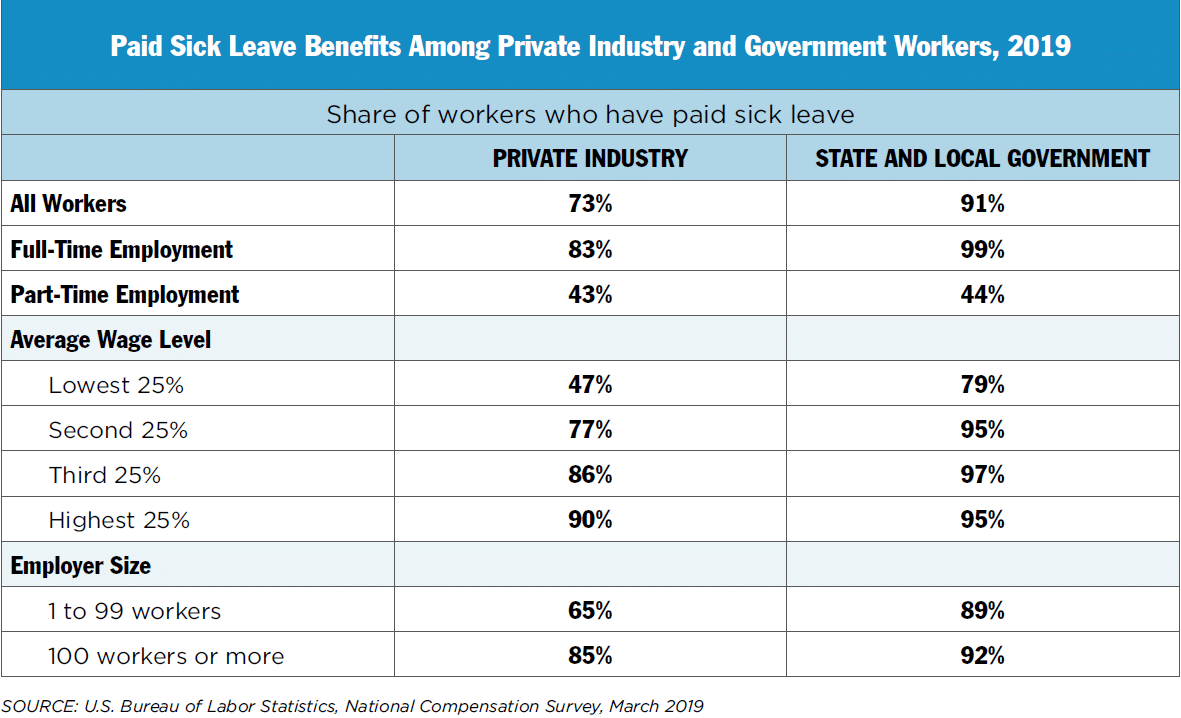Protecting Health & Maintaining Productivity

About This Report
No one could have anticipated the extent to which COVID 19 would profoundly change life as we know it literally overnight.
As the number of deaths and infections climbs, the world wakes up every day to realities that were previously unimaginable. National borders have been sealed. Schools, restaurants, bars, theaters and gyms have closed. Curfews have been imposed. Here in the United States, at the time of this writing, a shelter in place order has been issued in San Francisco, while another is pending in New York City.
There is no playbook for handling this crisis, but there is a growing amount of useful information from a variety of sources, with the CDC emerging as one of the most reliable outlets. While health care professionals and government officials are on the front line of our pandemic response, employers everywhere have quickly moved to implement work from home (WFH) policies, cancel events, restrict travel and implement measures to ensure employee and public safety.
Organizational leaders who have stepped up to the task of creating and implementing COVID 19 policies and procedures will not likely discover any new ideas in this report. Nevertheless, it is intended as a checklist of topics that organizations should consider when developing and updating plans to protect the health of their employees and maintain productivity during the uncertain times ahead.
Please note that this report is designed to provide you with insights, general information and resources about COVID 19 preparedness and does not constitute legal or medical advice.
Download
 hbspt.cta.load(123973, '97f1651a-f6d9-4e9f-a573-43b42d2e59d2', {});
hbspt.cta.load(123973, '97f1651a-f6d9-4e9f-a573-43b42d2e59d2', {});
Organize a COVID-19 Task Force
Organizations large and small have moved with remarkable speed to protect the health of employees and customers. However, as the crisis continues to evolve, many businesses are facing challenges in execution. These include:
- Reactive or scattershot policies that don’t include plans for longer-term business continuity and risk management
- A lack of coordination between different parts of the organization, i.e., supply chain, marketing, HR and operations
- The adoption of policies without consideration of the needs of different locations and employees
If your organization has yet to formalize a dedicated COVID-19 task force, consider that four departments should form the heart of your response planning. Your communications team should develop internal and external messaging. Your IT team should manage technical and security issues. Your legal team should analyze legal and regulatory compliance and advise on appropriate responses. Your human resources team should administer policies that ensure the safety, well-being and legally-compliant treatment of your workers. Your operations team should execute your strategy and oversee it in collaboration with the other task force members.
Formalize Communications Processes and Channels
With increasingly negative developments, fear, uncertainty and doubt grow, particularly in the absence of reliable information. First, consider the uninformed and panic-stricken buyers causing the current toilet paper shortage in the United States. Now, consider the far greater consequences of widespread uncertainty among employees. Business operators need to keep all employees informed and up to date on their organization’s plans, actions and policies related to COVID-19.
In times of crisis, a proactive communications strategy is essential in preventing unintended consequences. Responsibility for the execution of internal and external communications strategies must be clearly defined and formalized. The formulation of these strategies should be collaborative and subject to the approval of your COVID-19 task force and executive leadership. Build your communications strategy with the following objectives in mind:
- Craft a communications strategy that encompasses all stakeholders
- Prioritize communications on measures that ensure the safety and security of your workforce
- Carefully consider evolving federal and local advisories to ensure you’re in compliance
- Keep your customers informed about delays and potential impacts
Download
 hbspt.cta.load(123973, '97f1651a-f6d9-4e9f-a573-43b42d2e59d2', {});
hbspt.cta.load(123973, '97f1651a-f6d9-4e9f-a573-43b42d2e59d2', {});
Protect Workers and Workplace Environments
A lot of media attention has focused on employees working remotely. However, millions of employees in the United States are unable to do their jobs unless they’re at work, whether that be a facility or in the context of mobile services, like support and delivery. While large companies quickly moved to implement comprehensive workplace wellness, health and safety measures, many small and midsized organizations are still developing response plans. Assuming that your organization is not subject to a government-ordered closure, consider the following measures:
- Set aside additional time and resources to ensure the proper cleaning and sanitization of your workplace, particularly high-traffic areas
- Display posters outlining hand hygiene, germ containment and what people should do when they feel sick
- Encourage social distancing
- Place additional sanitation products, like gloves and soap, in areas that employees and customers can easily access
- Remind and encourage employees to use sick or vacation time if they feel sick
For links to more detailed advisories and resources, refer to page 9 of this report.
Enable Remote Work and Secure Practices
All organizations have moved quickly to implement WFH programs. Large businesses are well-equipped to provide remote access to business-critical applications in accordance with security and data protection policies. However, the vast majority of employers aren’t prepared to enable WFH programs for a prolonged period without experiencing considerable disruption and increased risk. In an article titled “Remote Working and COVID-19,” TechRadar offers five important considerations for WFH success.
- How will your existing processes be affected?
- What effect will WFH have on hardware?
- Who else will have access to information?
- Will you need to introduce any new technology?
- How will you manage WFH staff?
In addition to these considerations, employers must consider the increased security risks that result from remote access, insecure WiFi connections and cyberattacks, such as phishing emails. While your IT team, managed services and application providers are no doubt working diligently to address security issues, a top priority should be the implementation of WFH cybersecurity policies. An article published in The National Law Review—”Coronavirus (COVID-19): Managing Cyber Security Risks of Remote Work”—provides a detailed overview of important considerations.
Download
 hbspt.cta.load(123973, '97f1651a-f6d9-4e9f-a573-43b42d2e59d2', {});
hbspt.cta.load(123973, '97f1651a-f6d9-4e9f-a573-43b42d2e59d2', {});
Develop Flexible Staffing Plans for On-Site Workers
For organizations with essential staff that must perform on-site work, the CDC has issued the following recommendations in their Interim Guidance for Businesses and Employers:
- Prepare for possible increased numbers of employee absences due to illness in employees and their family members and dismissals of early childhood programs and K-12 schools due to high levels of absenteeism or illness.
- Employers should plan to monitor and respond to absenteeism at the workplace. Implement plans to continue your essential business functions in case you experience higher than usual absenteeism.
- Cross-train personnel to perform essential functions so that the workplace is able to operate even if key staff members are absent.
- Assess your essential functions and the reliance that others and the community have on your services or products.
- Be prepared to change your business practices if needed to maintain critical operations (e.g., identify alternative suppliers, prioritize customers, or temporarily suspend some of your operations if needed).
- Coordination with state and local health officials is strongly encouraged for all businesses so that timely and accurate information can guide appropriate responses in each location where their operations reside. Since the intensity of an outbreak may differ according to geographic location, local health officials will be issuing guidance specific to their communities.
Prepare for Shelter-in-Place Restrictions
Now that all 50 states have reported Coronavirus cases, state and local governments will be issuing new shelter-in-place orders in increasingly aggressive moves to stop the spread of COVID-19. One area of concern for many businesses anticipating local action is what is meant by “essential activities and business.” Functions considered essential under the current San Francisco shelter-in-place order are:
- Health care operations, including home health workers
- Essential infrastructure, including construction of housing and the operation of public transportation and utilities
- Grocery stores, farmers’ markets, food banks and convenience stores
- Support for economically disadvantaged individuals and shelter facilities
- Pharmacies, health care supply stores and health care facilities
- Gas stations and auto repair facilities
- Banks
- Garbage collection
- Hardware stores, plumbers, electricians and other service providers necessary to maintain the safety, sanitation and the operation of residences and businesses
- Educational institutions, for the purposes of facilitating distance learning
- Laundromats, dry cleaners and laundry service providers
- Businesses that ship or deliver food and other goods directly to residences
- Childcare facilities providing services that enable essential employees to go to work
- Services to “maintain basic operations,” including security, payroll and similar activities
Download
 hbspt.cta.load(123973, '97f1651a-f6d9-4e9f-a573-43b42d2e59d2', {});
hbspt.cta.load(123973, '97f1651a-f6d9-4e9f-a573-43b42d2e59d2', {});
Reevaluate Sick Leave and Benefits Policies
The Society for Human Resource Professionals (SHRM) recommends that HR organizations ensure employees are using their health, wellness and leave benefits to stay healthy or recover from the new Coronavirus. Many national organizations in the foodservice and hospitality industries have implemented or strengthened sick leave policies to cover hourly workers. On March 18, the Senate approved a new bill that will give workers affected by Coronavirus additional resources and guaranteed paid leave.
Benefit specialists advise employers to:
- Follow the guidelines posted by the Centers for Disease Control and Prevention (CDC).
- Encourage workers to use telehealth services, if available, unless their symptoms are severe.
- Use wellness programs to instruct workers about hygiene and disease prevention.
- Tell employees to stay home if they have a fever or cough and to seek care for severe respiratory distress.
- If employees need to be off work for a significant amount of time, try to be lenient about the use of leave.
Links for additional resources on sick leave and benefits policies are provided on page 9.
The following table, based on data from a March 2019 report from the US Bureau of Labor Statistics, shows the share of workers from private industry and state and local government who have paid sick leave.

Download
 hbspt.cta.load(123973, '97f1651a-f6d9-4e9f-a573-43b42d2e59d2', {});
hbspt.cta.load(123973, '97f1651a-f6d9-4e9f-a573-43b42d2e59d2', {});
Recognize Your Changing Workforce During the Pandemic
By Roy Saunderson, MA, CRP, Chief Learning Officer, Engage2Excel Group
Many companies have rolled out mandatory work from home (WFH) policies in response to the World Health Organization’s pandemic declaration, and this has created a new way of working for many employees accustomed to office life.
Recognition, communication and connectivity are important to employees. While the craziness of the current landscape is top of mind, those things should continue to happen. Now that many employees are no longer down the hall, employers need to communicate more often, find new reasons to recognize their staff and stay connected with different tools like Slack or Zoom.
Here are 10 ways to stay connected, communicate and recognize your “new” workforce.
1. Be a cheerleader: Whether employees are remote or still in the building, acknowledge their anxieties and concerns. Organizations should continue to communicate the latest updates from national health authorities and share any good news throughout the company to boost morale.
2. Appreciate the transition of first-time WFH employees: Recognize the challenges of WFH, provide tips on how employees can stay productive and, if possible, do a pulse survey. Also, don’t forget to reward your staff for demonstrating positive behaviors, especially if you have a points program.
3. Stay connected: Chat and messaging apps make it easy for remote employees to stay connected, ask questions and recognize each other for assisting on projects.
4. Provide tools and resources: Ensure staff has functioning laptops, mobile phones and access to collaborative software and other tools needed to work remotely.
5. Meet virtually: If you can’t physically meet with staff, have virtual face-to-face meetings using video conferencing apps. This can help you engage teams and catch up daily. Better yet, use this tool to gather coworkers and share recognition moments in front of a live audience.
6. Counteract loneliness: Encourage WFH employees to reach out to each other by phone. This overcomes the loss of productivity that social isolation can cause. It’s also an opportunity to recognize employees who support struggling team members.
7. Highlight the benefits of WFH: Most remote employees have fewer interruptions from peers when they work at home. WFH staff report reduced stress from not having to commute to work and getting a break from office politics.
8. Encourage online learning: Promote online courses through your learning management system or public learning courses. Invite employees to try LinkedIn Learning, Udemy or free online courses at universities. Then, recognize their initiative and newly acquired knowledge.
9. Remember to celebrate: Now that many employees are working from home, don’t forget to continue celebrating. Whether it’s an employee’s birthday or career anniversary, recognize them with eCards, video-recorded greetings or video conferencing, which is a great way to gather a large group of peers for a celebration.
10. Communicate timely: Virtual employees often feel ignored and like they’re the last people to learn about what’s going on. To address this, hold a weekly team conference call to share the latest updates and recognition moments, and send emails to remote employees first.

Roy Saunderson, part of Engage2Excel Group’s Trendicators division, is the author of Practicing Recognition and brings over 20 years of specialized knowledge in the field of employee recognition. Roy is coauthor of the Recognition Skills Assessment® (RSA), an assessment tool developed to determine behavioral strengths of managers in giving effective recognition to employees, and of CSX Develop management development modules for learning recognition behavioral skills.
Download
 hbspt.cta.load(123973, '97f1651a-f6d9-4e9f-a573-43b42d2e59d2', {});
hbspt.cta.load(123973, '97f1651a-f6d9-4e9f-a573-43b42d2e59d2', {});
Empower Managers to Be Effective First Responders
Managers and supervisors are the first responders in your COVID-19 response plan. They play a vital role in helping to reduce employee stress, answer questions and take steps to maintain health and productivity during this challenging period. Managers should be responsible for ensuring that every employee understands the organization’s COVID-19 recovery plan.
Common questions being asked by managers are:
- Can I ask an employee if he or she has COVID-19?
- Can I send a sick worker home?
- Is it okay to require a doctor’s note before allowing a person to return to work?
Approximately 40,000 people joined a webcast on March 11 coordinated by SHRM to discuss how employers should respond to COVID-19 workplace issues. Experts advised that while a manager can suggest that an employee with visible illness leave the workplace, asking too many questions might violate a worker’s rights, such as the Americans with Disabilities Act. Specific guidelines can be set regarding when a worker can return, such as how long it has been since the person’s last fever.
Regularly scheduled Q&A sessions for managers are vital to keeping them informed on policies, best practices, the latest operational plans and responding to customer and business partner issues.
Reassess Your Business Continuity Strategy
Even the best-prepared enterprises are racing to update and revise their business continuity plans based on unforeseen issues arising from COVID-19. For smaller organizations already struggling to support hastily prepared remote work arrangements, the idea of developing a formalized business continuity plan can seem like a daunting task.
Experts advise taking three immediate steps:
- Review your organization’s needs, and formulate a strategy to optimally facilitate communications and collaboration in a quickly changing business environment.
- Develop short-term strategies to minimize disruption to operations and ensure the safety of workers and the public.
- Charge your COVID-19 Operations Task Force (see page 3) with the development of a longterm strategy to ensure the resiliency required to see your organization through whatever the pandemic response may yield in the weeks and months to come. This plan should be updated regularly because the most certain aspect of the “new normal” will be the ability to adapt to constant change.
Comprehensive resources for business continuity planning are available from the US Department of Homeland Security.
Download
 hbspt.cta.load(123973, '97f1651a-f6d9-4e9f-a573-43b42d2e59d2', {});
hbspt.cta.load(123973, '97f1651a-f6d9-4e9f-a573-43b42d2e59d2', {});
COVID-19 RESOURCES
CRISIS COMMUNICATIONS
Responding To Coronavirus: A Playbook For Marketing And Communications
How to lead in times of crisis
Best Practices for Coronavirus Communications & Preparedness
Coronavirus Crisis Comms Triage Kit
How to communicate COVID-19 information in your organization
WORKPLACE SAFETY
Interim Guidance for Businesses and Employers
US Chamber of Commerce Foundation: Guidance for Employers
U.S Department of Labor Coronavirus Resources for Workplace Safety
Employee safety during Coronavirus
IT AND SECURITY
Coronavirus (COVID-19): Managing Cyber Security Risks of Remote Work
Working from Home: COVID-19’s Constellation of Security Challenges
Roundup: Coronavirus COVID-19 pandemic delivers array of cybersecurity challenges
Cybersecurity in the Time of COVID-19: Keys to Embracing (and Securing) a Remote Workforce
TRAVEL RESTRICTIONS
CDC Coronavirus Disease Travel Advisories
WHO: Coronavirus disease (COVID-19) travel advice
U.S. Department of State Information for Travelers
Department of Homeland Security: Notices of Arrival Restrictions Due to Coronavirus
EMPLOYEE ENGAGEMENT
Recognizing Your Changing Workforce
BUSINESS CONTINUITY
Coronavirus: HR’s role in business continuity plans
Coronavirus Pandemic: 7 Business Continuity Planning Guidelines for HR
Business Pandemic Influenza Planning Checklist
COVID-19 Business Planning Checklist
National Small Business Association: Small Business Impact Poll
U.S. Department of Homeland Security: Business Continuity Plan